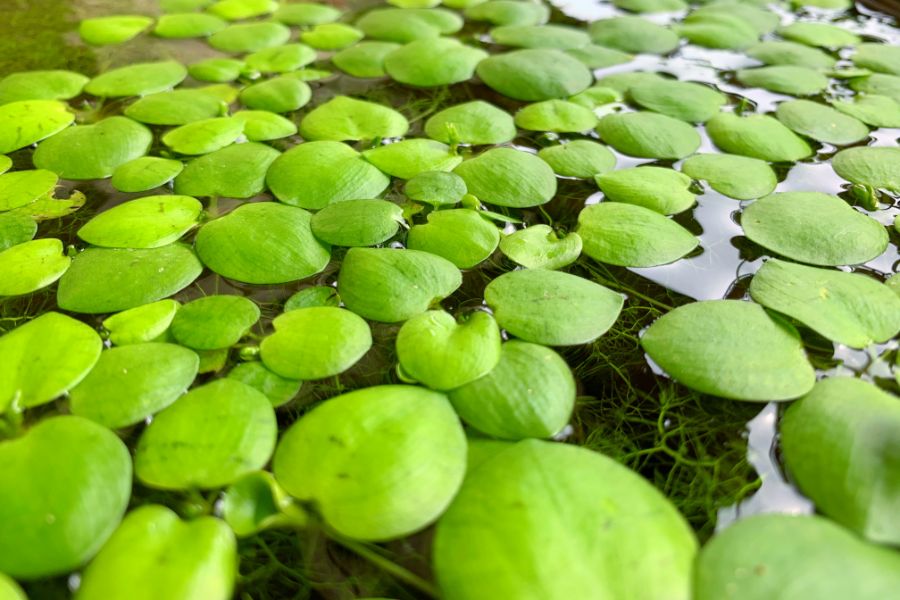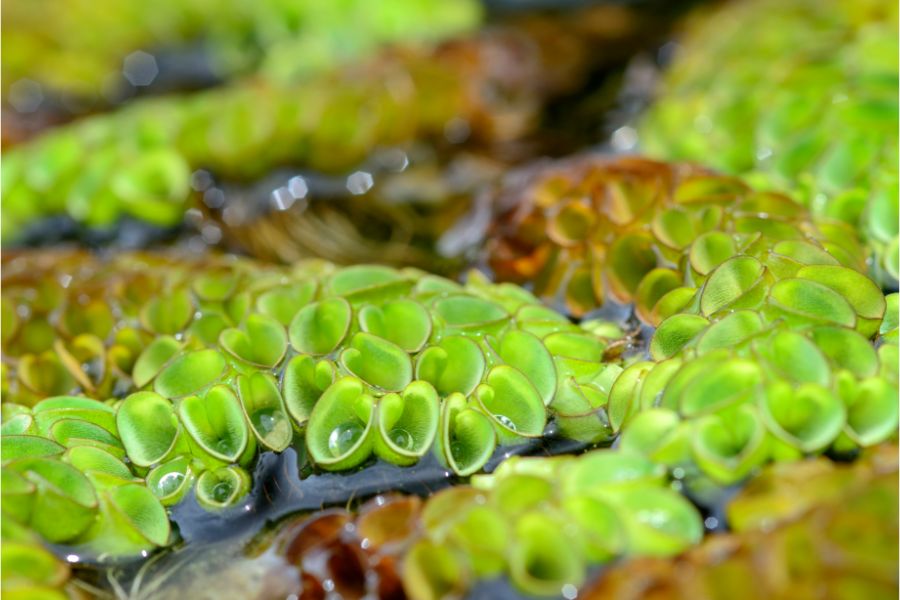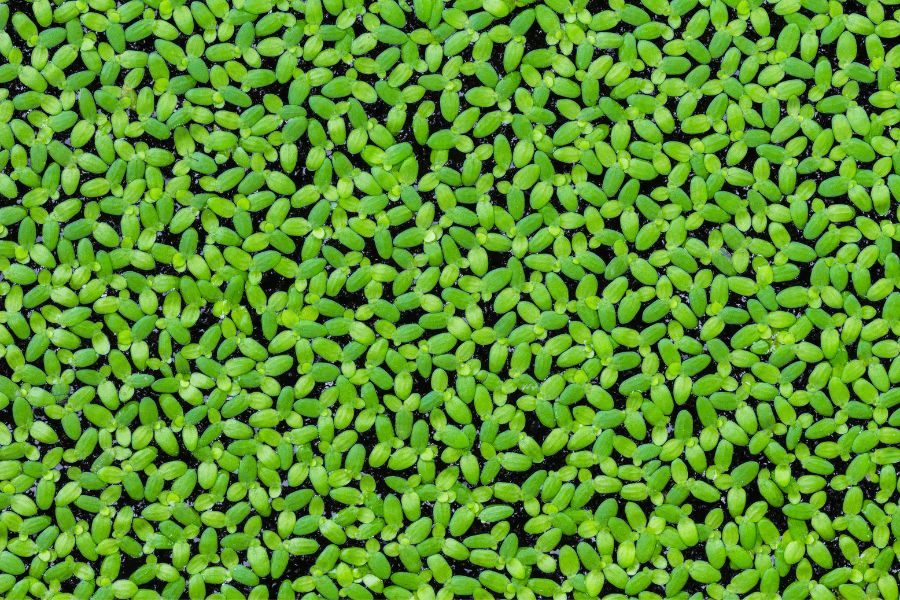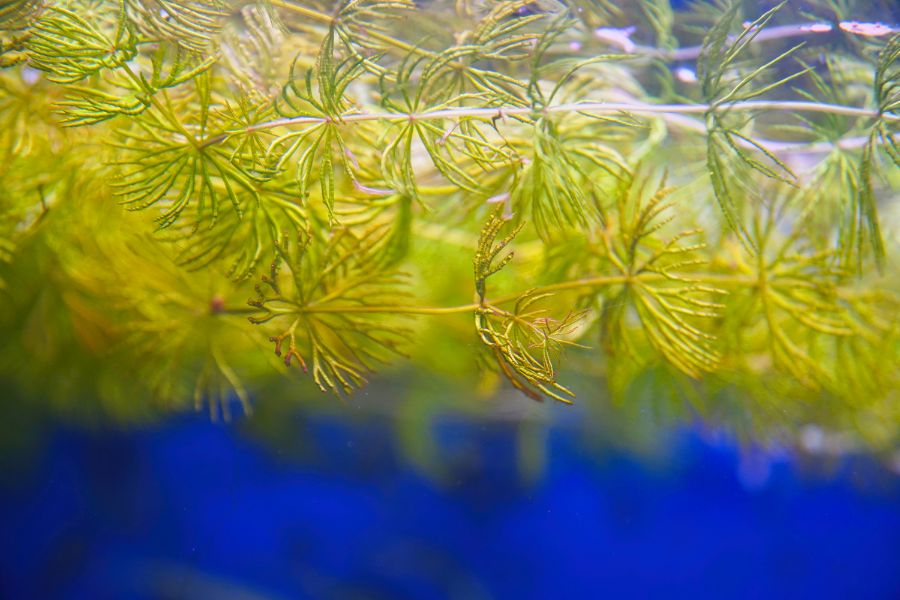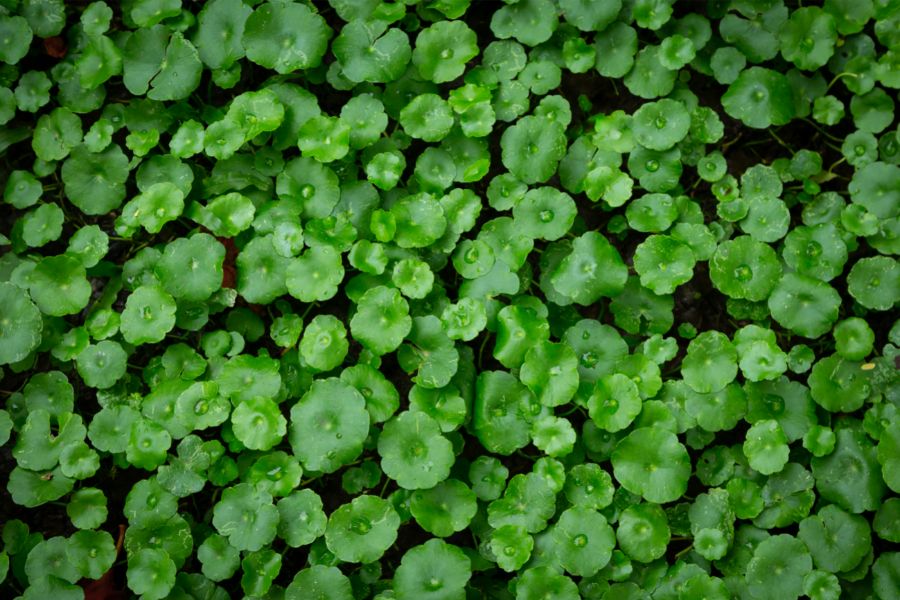Floating plants are used widely in fish parks, pet shops, and home aquaria (including outdoor tanks and ponds). They are a living asset for every enthusiast who has a planted aquarium.
Despite their popularity, only a few know the genuine value of floating plants. You may know their aesthetic impact and how they beautify your tank, but it doesn’t end there. There’s more to floating plants.
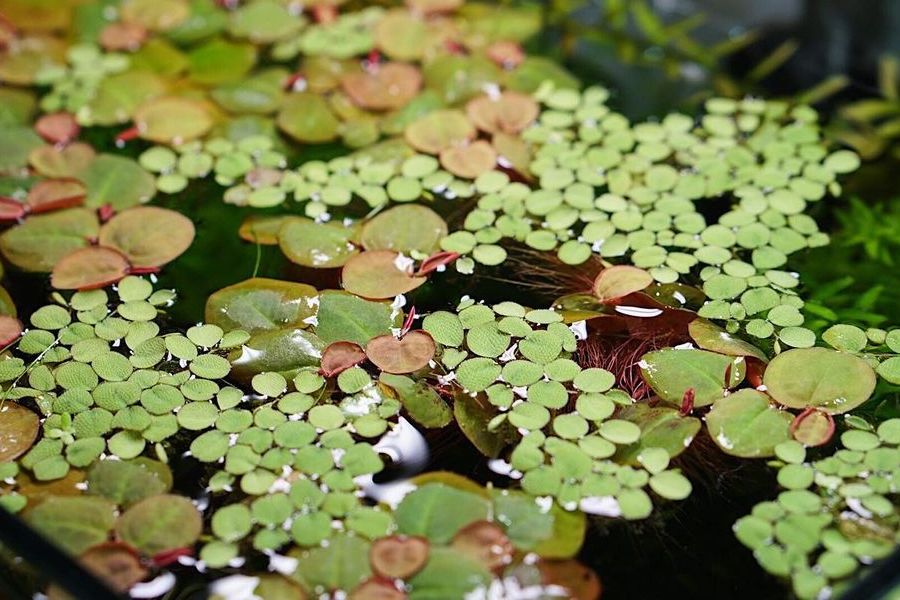
In this article, you will learn everything about floating plants and have a better perspective the next time you see them, even if you are a newbie.
Best Floating Plants for Aquarium
In this section, we will focus on authentic floating plants.
In some articles, you will see that they have included some aquatic plants that can be placed in floating pots or have excessive vertical growth, and their presence in the surface water is considered a basis for them to become floating plants.
That is not the case in this section. Without any form of support or frame, true floating plants should float on their own.
Amazon Frogbit (Limnobium laevigatum)
The amazon frogbit has broad leaves measuring 1 to 2 cm in diameter. Adding more to buoyancy, it has a spongy texture on the underside of its leaves, thus its alternate name: the South American sponge plant.
Its roots are long and branching and provide good hiding places for small fish and shrimps. Just be cautious about their roots since they can get entangled with other plants and break off in a strong water flow.
Amazon frogbit does well in betta fish tanks or an aquarium with slow-moving waters and moderate to good lighting. In a poorly lit tank, their leaves fade and die off.
Red Root Floater (Phyllanthus fluitans)
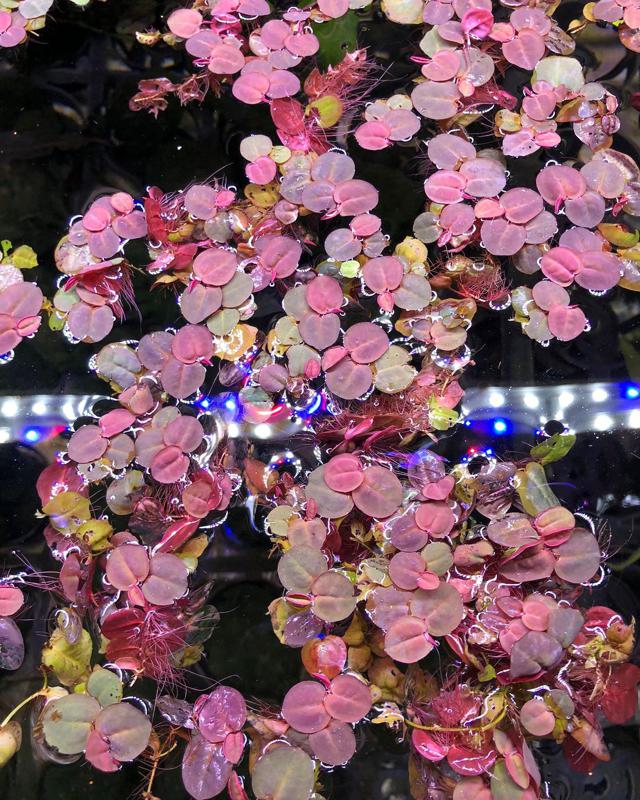
While most small to mid-sized floating plants look the same, identifying a red root floater is a no-brainer as its roots and leaf margin are colored red and are only evident to this plant.
When you have a newly purchased red root floater, you will notice that the entire plant is colored green. Do not panic or mistakenly think that you bought the wrong plant.
During acclimation, place the plant under intense lightning. Slowly you will see how their red color comes back. You can also use direct sunlight. But don’t be surprised if the whole plant turns red since it is their photosynthetic response.
Red root floaters perform well in tanks with lids. While other floating plants cannot adjust to humid environments, red root floaters adapt well to a high-moisture ecosystem.
Diseases in this floating plant can indicate an imbalance in water chemistry. If you see pin holes in their leaves, it is a sign of potassium deficiency.
Water Lettuce (Pistia stratiotes)
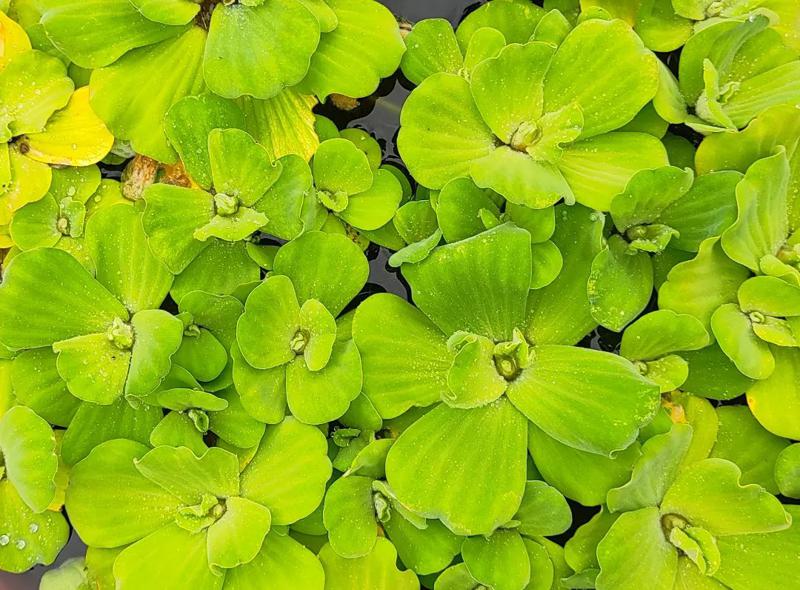
Another floating plant that is easy to identify is the water lettuce. It has parallel veins and wavy margins in the leaves that look like lettuce.
Initially, their leaves are small at 2 cm average size. However, with their preference for moderate to intense lighting, their leaves can grow as big as 15 cm.
You can manipulate the growth of their leaves by adjusting the flow of water. If your aquarium has a strong water flow, expect small leaves.
However, this floating plant will grow big if you control and lessen water flow. Just be aware that if you want this floating plant to grow big, lower the aquarium water level, as it may reach the light or the lid cover.
Water Spangle (Salvinia minima)
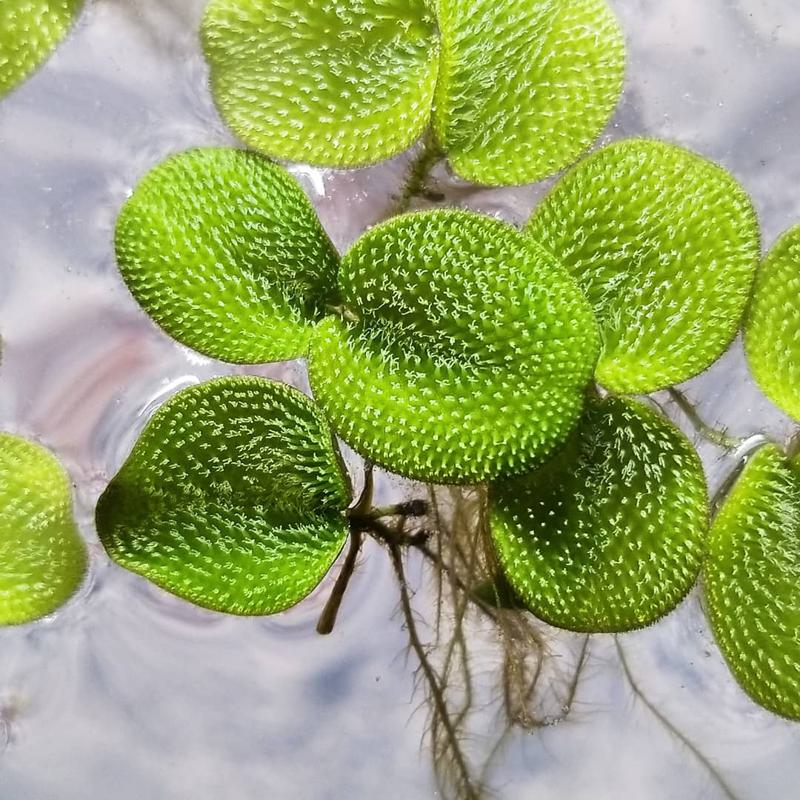
Water spangle or Salvinia minima is easy to identify. While its leaves look like moringa, each leaf has loop hairs that are not readily visible to the naked eye. Focus on your eyesight and see how tiny the hairs are.
This floating plant is relatively small. Its leaves range from 0.5 to 2 cm, and its roots are relatively short. They can live in moderate lighting conditions, but use intense lighting if you want them to spread out fast.
Water spangle loves a low water flow, and their tiny size makes them the perfect match for your betta fish.
Asian Watermoss (Salvinia cucullata)
A close cousin of the water spangle is the Asian water moss.
At first, their leaves look like those of a water spangle with the same loop hair structures. However, as they develop, the leaves will roll up to form a hood.
Although these floating plants can survive moderate light conditions, they require intense lighting for the leaves to roll up. The more light, the more the leaves roll up. As the leaves branch out and roll up, the entire plant will appear like a hair comb.
With their Asian origins, these floating plants do well in warm water aquariums or partly flooded tanks with marshy or swampy conditions like a riparium or paludarium.
Duckweed (Lemna minor)
The last on our list of the true floating plants is the duckweed. We decided to place it on the last since this plant has varied opinions from aquarists. Some say they are good, while some say they are bad.
Duckweed is one of the easiest floating plants to handle. Their flat leaves are egg-shaped and tiny measuring only from 2 to 7 mm long. Its mid-sized roots are simple and have no secondary growth.
While duckweeds are easy to handle, they can grow out of control and this is where the problem sets in. Their tiny leaves can potentially cover the entire surface water leaving no space for light penetration.
Summary of the best floating plants for aquarium
| Name | Root length | Leaf size | Light requirement | Water flow |
| Amazon frogbit | Long | 1 – 2 cm | At least Moderate | Low |
| Red root floater | Short | 2 – 3 cm | High | Low |
| Water lettuce | Mid-sized | 2 – 15 cm | Moderate to High | Low |
| Water spangle | Short | 0.5 – 2 cm | High | Low |
| Asian watermoss | Mid-sized | 2 – 3 cm | High | Low |
| Duckweed | Mid-sized | 0.2 – 0.7 cm | Moderate | Low |
Rooted Plants as Floating Plants
In this section, we will present popular aquatic plants traditionally rooted in the substrate that can also become floating plants.
If you already have aquatic plants, please check them in this list to see if they can also serve as floating plants. In this way, you don’t need to spend money just to have floating plants.
Water Sprite (Ceratopteris thalictroides)
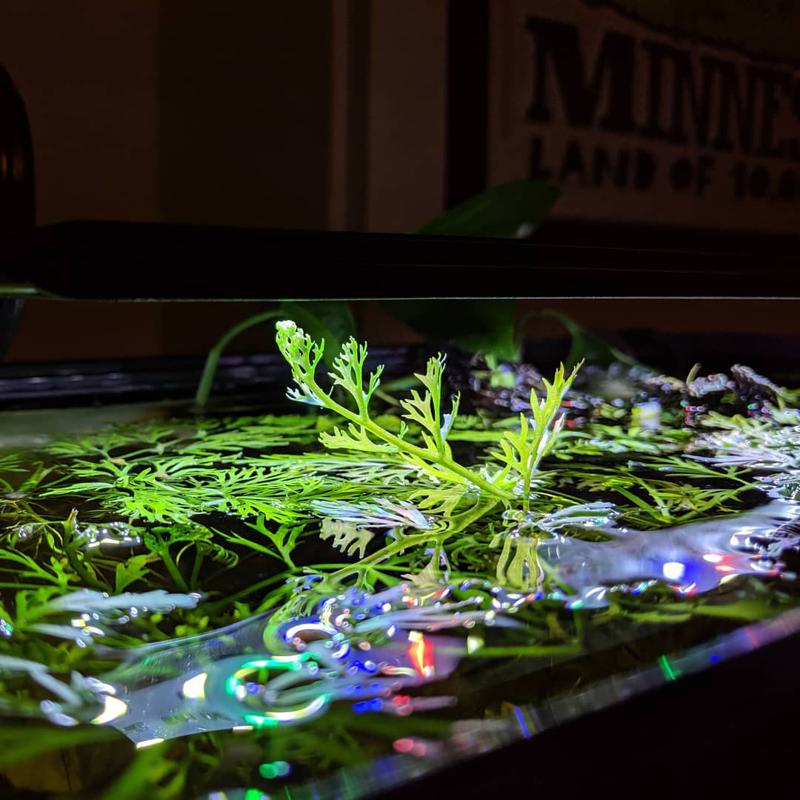
The fern-like leaves of water sprite provide refuge for small fish and shrimps and this is why they are commonly used in a community tank.
We do not recommend uprooting your existing water sprite just for the sake of having floating plants. Use plants that are broken or dislodge naturally from the main plant.
Pick out the broken plant and save their stems and leaves. Release them in the water and allow them to float naturally. After a few days, roots will start to grow and hang, just like the roots of true floating plants.
Hornwort (Ceratophyllum demersum)
Although hornwort is commonly planted in the substrate or attached to a driftwood, they grow and function best as a floating plant.
At the surface, they have more access to light and can extract more carbon dioxide from the air. In effect, they flourish to a point that they produce dense floating forest.
Hornworts are recommended for cold-water aquariums.
Cabomba (Cabomba caroliniana)
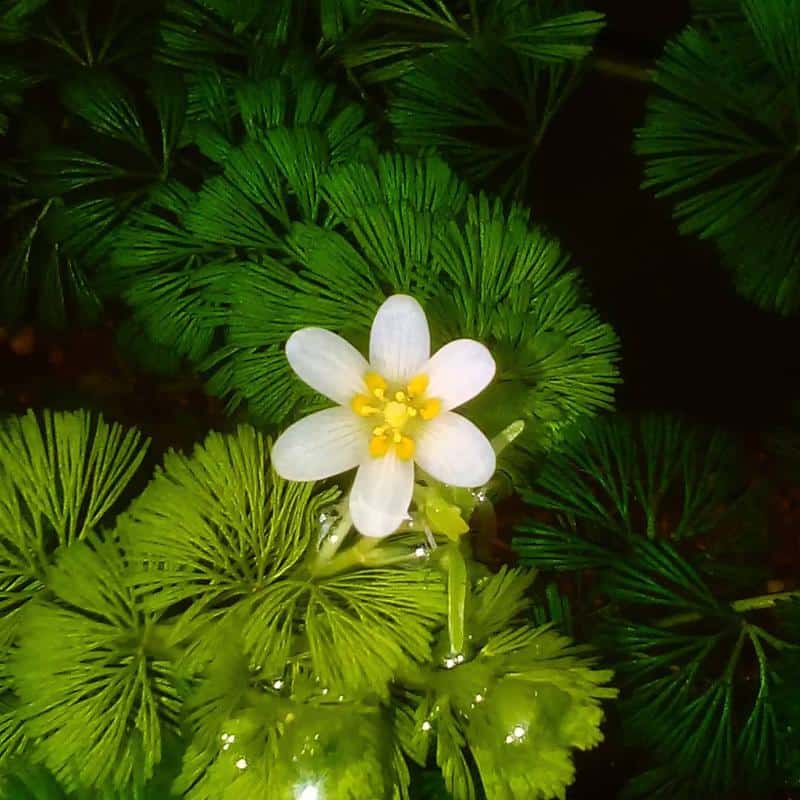
Cabomba is a weed often used as a background plant. Aside from being a rooted plant, Cabomba can also be used as a floating plant.
When freely floating on the surface, they create a dense mass of pale green leaves perfect for juvenile and small fish. This is why they are preferred in shrimp tanks.
Pennywort (Centella asiatica)
On top of serving as a background plant, pennyworts are great floating plants.
Since they get more light at the surface, they will grow fast. In reproducing at the surface, they send out stems that produce green leaves and resemble a lily pad.
While their aesthetic effect is similar to a frogbit, they outscore the said true floating plant as they can withstand strong water flow.
Water Wisteria (Hygrophila difformis)
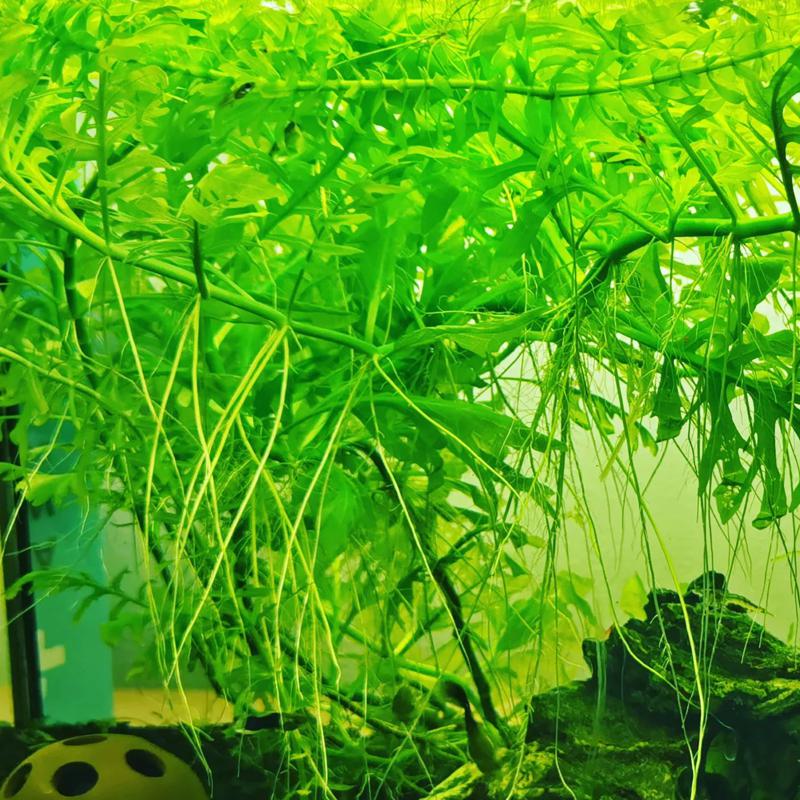
If you’re looking for a floating plant that can withstand strong water flow, then consider having the water wisteria. Their thick stems are durable and will not break off easily.
The good thing with floating a water wisteria is that a good part of the plants is submerged and you will have a nice view of the plant underwater. Further, all their stems converge at a central root system which resembles an inverted cup.
Benefits of Floating Plants
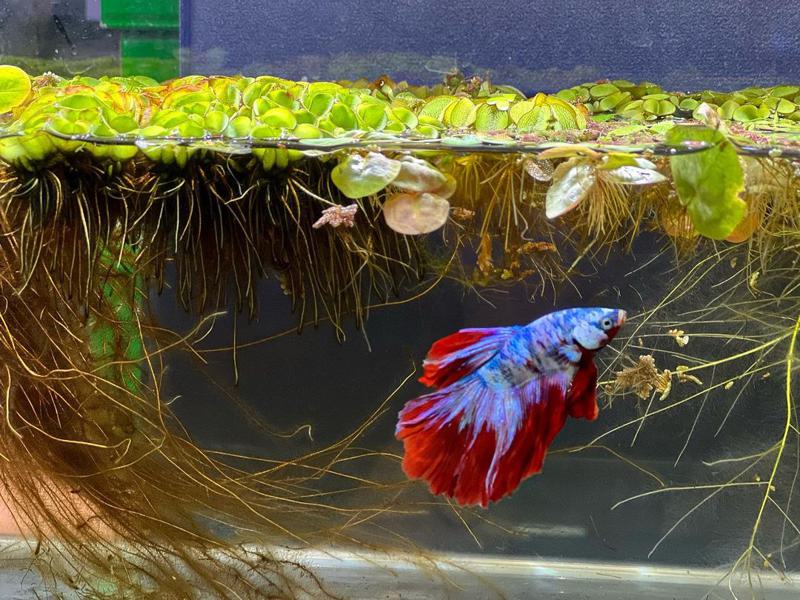
Thanks to science and the internet, many aquarium hobbyists have shifted their reason for using floating plants. From mere decorative plants, they are now used to become a part of the biological ecosystem of an aquarium due to the following benefits:
Provides Natural Shade
If you were to choose a house to live in, do you want it roofed or roofless? Of course, you will always choose to live in a house with a roof.
In the case of floating plants, since they occupy the surface waters, they provide a natural shade and can be considered a natural roof for your home aquarium.
As an effect of this, your fish and other tank residents (like shrimps) will feel secure and protected, enticing them to go out of their hiding places and explore the shaded environment provided by floating plants.
Further, the shade provided by floating plants will attract your fish to feed and breed.
Focusing on the roots of floating plants, they create a suspended web that traps floating particles and will become food for your adult fish. For juvenile fish, the root system of floating plants will soon become their feeding grounds once biofilm or packs of microorganisms start growing.
Acts as Natural Filters
We use mechanical filters to clean our tank water. Floating plants supplement these artificial tools as they can act as natural filters.
Floating plants absorb unwanted chemicals like phosphates, ammonia, nitrites, and nitrates from fish waste and leftover foods. They convert these chemicals into proteins and use them for growth.
The more chemicals floating plants absorb, the faster they grow. And the good news is that most floating plants are fast growers.
So, if you’re planning to have an extra filter, you will never go wrong with floating plants. And besides being environmentally friendly, they are cheaper than most mechanical filters.
Floating plants also control algae growth. Algae and floating plants are fierce competitors when it comes to absorbing chemicals. However, floating plants have a higher absorption rate, leaving less or nothing for the algae.
Unlimited and Constant Aeration During Daytime
As long as there is light, all aquatic plants aerate the water. Through photosynthesis, they absorb carbon dioxide and release oxygen in exchange.
With rooted aquatic plants, their oxygen production is dependent on the carbon dioxide present in the water. However, the strategic location of floating plants allows them to have two sources of carbon dioxide: the air and the water.
In effect, floating plants provide unlimited aeration during day time. While it means that they produce more oxygen than rooted plants, it does not mean that you no longer need a mechanical aerator. You still do since oxygen levels can suddenly drop, especially if you have more fish living in a single tank.
Improves Natural Aesthetics
Once you place your floating plants in the aquarium, you will immediately see how it changes the scenery. Floating plants are not mere decorations. Their presence in the aquarium creates a natural appearance.
And it doesn’t stop there. The natural beauty of floating plants will improve over time, especially if the root system has already developed. The spreading of the roots will create a natural labyrinth for fish to swim by, just like in their wild habitat.
Other Benefits
Depending on the species, some fish can jump out of the aquarium. But with the layer of cover provided by floating plants, fish jumping is significantly reduced, especially for aquariums that do not have a lid.
We humans also benefit from using floating plants in our aquarium.
Since floating plants absorb unwanted chemicals, there is less frequency in changing the water and less use of test strips to monitor water chemistry. By that, we saved time, money, and effort.
Drawbacks of Floating Plants
Using floating plants does not just bring benefits to your aquarium. It has traits and characteristics that may create unfavorable conditions.
Surface Cover-Up
Floating plants are fast growers. They multiply rapidly by producing runners from a slender stem that breaks off to become a new plant.
In no time, these runners will be densely populated and cover up a majority, if not the entire surface water, and will lead to a series of problems.
Light Obstruction
Aside from chemicals, light is one of the reasons why floating plants grow fast. Ideally, floating plants only require moderate light. However, as commonly practiced, we place overhead lamps in our aquarium. Intense lighting causes increased photosynthetic activity, which in turn, allows their rapid multiplication.
Upon stocking, floating plants may partially impede light as their numbers are still few. But as they multiply and send their runners out, they will reach a point where they can completely block the light.
Dominate Other Plants
Let’s say we have an aquarium with floating plants and rooted plants. Which do you think will dominate in terms of growth? If your answer is floating plants, then you are correct.
There are two factors why floating plants dominate over rooted plants and other aquatic plants.
The first factor is their voracious appetite for chemicals. While they already have an atmospheric source of carbon dioxide, floating plants still compete in carbon dioxide absorption in the water. And not just any absorption, but they absorb more than rooted plants.
In effect, chemical nutrients left for rooted plants are limited to a few, thus stunting their growth.
Second is the obstruction of light. Floating plants get all the solar nourishment they need since they are at the top-most part of the aquarium. Their leaves will grow bigger while runners are branched out, blocking more light.
With limited light penetration, the rooted plants are left behind with a small amount of solar energy for photosynthetic growth, making it a double jeopardy in stunted growth.
Root Entanglement
Depending on the species, the development of roots in floating plants is the same as how fast their leaves grow. It means that floating plants will have an extensive root system in no time.
While their suspended roots provide a natural habitat for fish, they can also be entangled, especially for fish with intricate fin systems.
Not only for fish, but the roots may intertwine with rooted plants or clog your filters. In this case, you need to act immediately and clear the blockage.
Oxygen Depletion in The Absence of Light
We already know that floating plants absorb carbon dioxide and release oxygen during the daytime or in the presence of light.
But during the night, it does the opposite. In the absence of light, floating plants take up oxygen and release carbon dioxide in the process called plant respiration.
Each floating plant does this, and oxygen can deplete if the population of floating plants is dense.
It is why you cannot solely depend on floating plants as your only source of oxygen. We should remember that light is not present at all times, and having a mechanical aerator is still vital.
Summary of the benefits and drawbacks of floating plants
| Benefits | Drawbacks |
| Provide natural shade | Surface cover up |
| Act as natural filter | |
| Unlimited and constant aeration during daytime | Dominate other plants |
| Improve natural aesthetics | |
| Reduce water change | Oxygen depletion in the absence of light |
| Prevent fish jumping |
How to Add and Maintain Floating Plants
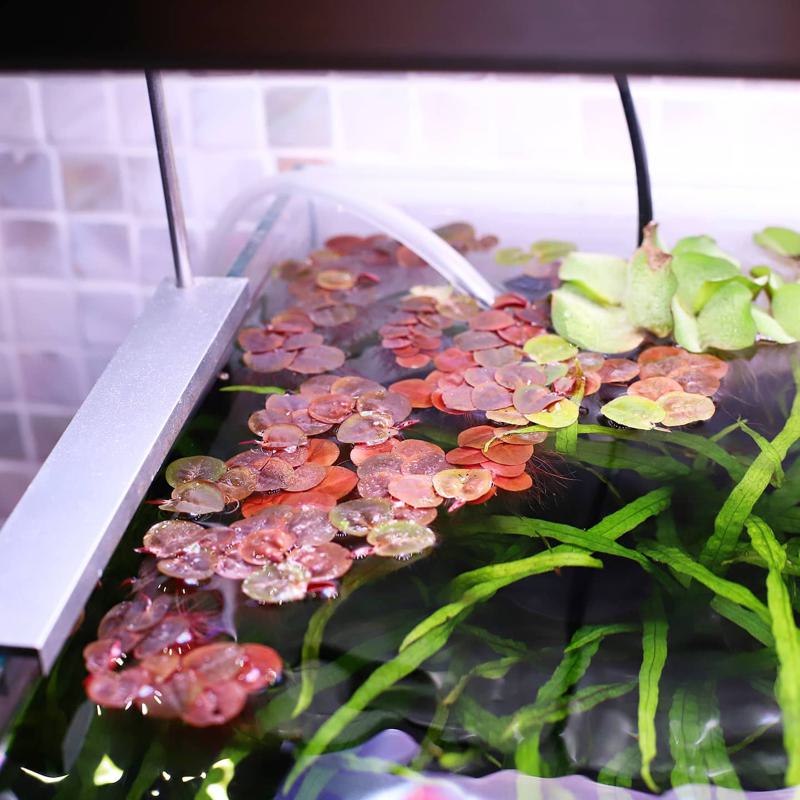
Once you have floating plants (whether you purchase them online or at the pet shop), it does not mean that you can place them immediately in your aquarium.
Acclimate
You need to acclimate them first, especially if you order them online.
Remember that packaging is usually dark and sealed. Upon arrival and unpacking, put them in a container with water similar to the conditions of your tank. Allow them to settle down and adjust for 24 hours. Do the acclimation indoors and not outdoors.
Stocking
After the 24-hour acclimation, you can place the floating plants in the aquarium. Only stock and occupy a quarter of the surface space. Do not stock up and cover the entire surface water.
Light Requirements
Floating plants only require moderate lighting. If you are using an overhead light, be prepared for rapid development. It only takes a few days to see the spreading of their growth.
Aerator and Filter Position
The most common setup we see with aerators and filters is that they are placed on both sides of the aquarium. This position will create strong water flow and may not be conducive for floating plant growth.
We recommend that you only place the aerator and filter on one side of the aquarium. In this way, there will be a one way flow which mimics their natural environment.
Further, you can install a valve in your air hose so you can control the flow. The gentler the flow, the better for floating plants.
Transfer and Trimming
Once you see their population is getting thicker and thicker, do not wait for a complete surface cover-up. Pick up and transfer the excess plants to a new aquarium.
Simultaneously, once you clear a portion of the surface, you can trim overgrown roots. For floating plants with long roots, be careful as they may entangle with other plants and cut them in the process.
Plant Ring or Line Holder
Installing a plant ring or line holder controls the spreading of floating plants.
While there are commercially available plant rings, you can make your own by using scrap air hose. Cut your desired length and join the 2 ends to form a circle.
Place your floating plants inside the plant ring. If you want a bigger space, you can install a line holder using the same air hose. Just attach one end of the air hose in the front glass of your aquarium and another at the opposite back end of the tank.
Read More:
- Best Aquarium Plants That Grow Tall
- Best Aquarium Plants for a Sandy Substrate
- Best Carpet Plants for Aquarium
- Best Aquarium Plants with Flowers
- Best Low Light Aquarium Plants
Floating Aquarium Plants: FAQs
Why Do Floating Plants Float?
Floating plants have cavities in their soft cellular tissues, particularly in their leaves and stems. These cavities create air pockets that make the plant positively buoyant and float.
In comparison, negatively buoyant plants will sink.
Are Floating Plants Good or Bad?
The answer will depend on the situation.
If you have the time to monitor and control their growth, then floating plants are good as they give off many benefits to your aquarium.
However, if you leave them behind, then they grow out of control covering the entire surface of your tank which impedes light and dominates other plants in the aquarium.
Why Do Floating Plants Grow Faster than Rooted Aquatic Plants?
The source of nourishment is the main reason floating plants grow faster than rooted aquatic plants.
Rooted aquatic plants get nutrition from the nutrients present in the water. On the other hand, floating plants receive nourishment simultaneously from the water and the atmosphere.
With photosynthesis, rooted aquatic plants receive less solar energy as water absorbs light. In contrast, the direct illumination of floating plants means they produce more food for their growth.
Conclusion
It is clear that having floating plants has benefits and drawbacks. But what is good in this article is that we were able to identify, describe and address the advantages, and especially the disadvantages.
At the end of the day, the benefits of floating plants outweigh its drawbacks. But again, it doesn’t mean that you leave them behind despite the fact that they are biologically and chemically beneficial to your tank and fish.
Just like in any other task in aquarium keeping, keeping floating plants requires time and effort. And we guarantee you that your efforts are often rewarded with a stunning greenery made by your floating plants.
